Islamic Golden Age - Photo gallery
Image database with photographs of ancient art and antiquities
Our image database provides photographs of ancient art and antiquities for press releases as well as for private use. All artefacts sold in our gallery are documented through professional photographs. The resulting image library contains numerous ancient Egyptian, Greek and Roman antiquities as well as ancient coins. The time span from Stone Age, over Bronze Age and Classical Antiquity until Late Antiquity is covered.The photo gallery aims at providing a vast visual archive equipped with filters and search tools. You are most welcome to search the constantly growing number of artefacts in the image library. We are also happy to authorize hyperlinks from your webpage / forum to the objects depicted in our gallery. For this purpose, please send us a short notification prior to placing a hyperlink. For almost every object high definition photographs are available and can be provided e.g. to document your collection or for scientific papers or popular science articles. If you are interested in using pictures for publications, print media or other purposes, please contact us and we will be happy to assist you.
-
 Egyptian green stone vessel
Egyptian green stone vesselThe stone vessel is made of beautiful green serpentine. From the collection of Egyptologist Professor Wiedemann. Middle Kingdom of Ancient Egypt.
Price: on request Egyptian bronze statuette of Amun
Egyptian bronze statuette of AmunIt impresses by its size and artistic quality. An inscription identifies the piece as votive offering at one of Amun's temples. From the Late Period of Ancient Egypt.
 Egyptian ushabti
Egyptian ushabtiWell-preserved funerary statuette made of mint green faience. From the Late Period of Ancient Egypt.
Price: on request Large Egyptian sarcophagus mask
Large Egyptian sarcophagus maskMagnificently painted wood relief of an idealized face. A piece of outstanding size and quality. The mask was part of a sarcophagus lid from Ancient Egypt.
 Cypriot milk bowl
Cypriot milk bowlThe hemispherical pottery bowls of this type were a successful export good of Late Bronze Age Cyprus. They are nicely decorated with bands of hatch-patterns.
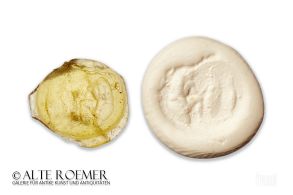 Roman intaglio with kneeling person
Roman intaglio with kneeling personNice light yellow glass paste from the Professor Brosch collection of ancient glyptics. Possibly showing a warrior.
Price: on request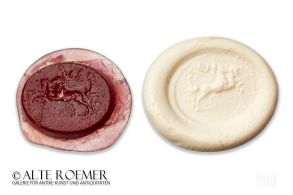 Roman intaglio with biga
Roman intaglio with bigaThe glass paste shows Nike in a biga. The goddess of victory stands in the chariot, holding the reins and her laurel wreath.
Price: on request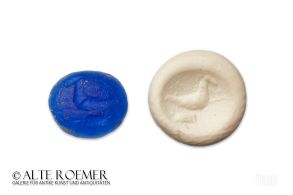 Roman intaglio with mythical creature
Roman intaglio with mythical creatureRoman jewellery insert made of beautifully shimmering blue glass paste. It shows a creature with the front part of a horse.
Price: on request Roman marble head of a woman - ex Duke University of Art Museum
Roman marble head of a woman - ex Duke University of Art MuseumBeautiful, life-size portrait. The provenance can be reconstructed until 1920, when the portrait was acquired from Jannis Demetrios Mikas by Ernest Brummer, both famous collectors.
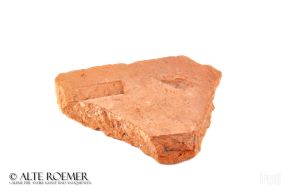 Roman legionary tile from the Rhineland
Roman legionary tile from the RhinelandLEG XVI (Gallica), 43 - 70 AD. Found 1966 till 1981 near the Roman city of Novaesium, today's Neuss in Germany. Novaesium was an early Roman foundation and with this is one of the oldest cities in Germany.
Price: on request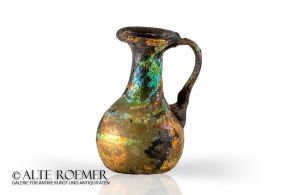 Roman glass juglet
Roman glass jugletThe small jug with a pear-shaped body is outstanding due to the strongly iridescent patina and the dark coating on the outside. From the Late Roman Imperial period.
Price: on request Roman bowl of colourful ribbon glass
Roman bowl of colourful ribbon glassThe bowl was made in mosaic glass technique. It is truely a work of art and a showpiece for the glass production in the Roman core region during the Early Imperial period.
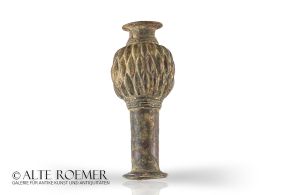 Luristan macehead
Luristan maceheadThe bronze head belonged to a club that was probably worn like a badge of rank in military parades. Very similar finds come from War Kabud and Chamzhi Mumah in what is now Iran.
 Luristan bronze dagger
Luristan bronze daggerDouble-edged blade of a short dagger from the Luristan region in Ancient Iran. An early type from the Middle Bronze Age.

 Luristan bronze dagger
Luristan bronze daggerIron Age bronze weapon originating from the Luristan region in Ancient Iran. Well preserved.
 Egyptian faience figurine of Pataikos
Egyptian faience figurine of PataikosWonderfully detailed protective amulet from Ancient Egypt. The dwarf god stands on crocodiles with daggers in his hands. Ex-Sotheby's.
 Roman headstud brooch
Roman headstud broochInteresting fibula with a covered hinge mechanism and enamel decoration on the bow. From the 2nd century Roman Britain. Published in two stardard works on ancient brooches by Richard Hattatt.
Price: on request Roman knee brooch from Britannia
Roman knee brooch from BritanniaWell preserved example of this important fibula type that was introduced to Britain by Roman troop movements from the Rhineland. This specimen was already produced locally in Britannia province. It was published in two books on ancient fibulae.
Price: on request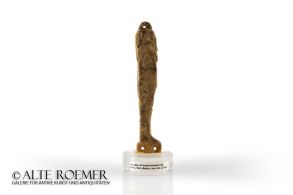 Appliqué of the Horus Son Imsety
Appliqué of the Horus Son ImsetyRare variety with wooden core and gilded linen. Protective god responsible for the liver of a deceased. From the family of Lawrence of Arabia.
Price: on request Egyptian bronze figurine of Horus the Child
Egyptian bronze figurine of Horus the ChildAmulet of a standing child god with crown, sun disc and horns.
Price: on request Mesopotamian stamp seal in bull shape
Mesopotamian stamp seal in bull shapeThe perfectly preserved seal is from the Jemdet Nasr period. The stamp shows two goats.
 Phoenician glass head pendant
Phoenician glass head pendantPolychrome glass jewellery with a plastically moulded face of a woman. A product from the Phoenician culture, created around 400 BC.
 Phoenician glass head pendant
Phoenician glass head pendantPolychrome glass jewellery with a plastically moulded face. A product from the Phoenician culture, created around 400 BC.
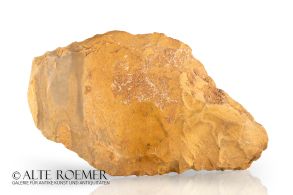 Paleolithic hand axe
Paleolithic hand axePrehistoric stone tool. It was the universal tool of the older Stone age and could be used as a borer or a cutter. From a Swiss museum collection. Found in Morocco, North Africa.
Price: on request Huge Paleolithic hand axe
Huge Paleolithic hand axePrehistoric stone tool. It was the universal tool of the older Stone age and could be used as a borer or a cutter. From a Swiss museum collection. Found in Morocco, North Africa.
Price: on request Pre-Columbian gold earrings from Colombia
Pre-Columbian gold earrings from ColombiaMatching pair of gold earrings from the Zenú culture. Dating to the 1st millennium. Impressive gold jewellery, once worn as earrings by the Zenú people.
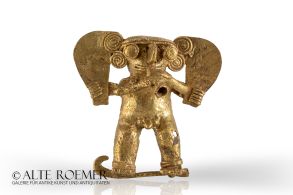 Gold figurine of a flute player from Panama
Gold figurine of a flute player from PanamaA fine gold work once worn as a pendant around the neck by an elite. The small male figure was made by a largely uniform Panamanian culture, right before the old crafts disappeared under the influence of the Spaniards.
 Pre-Columbian gold earrings from Colombia
Pre-Columbian gold earrings from ColombiaMatching pair of gold earrings from the Zenú culture. Dating to the 1st millennium. Impressive gold jewellery with highly stylized waterbirds. Once worn as earrings by the Zenú people.
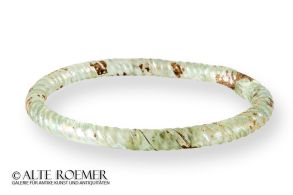 Roman glass bracelet with spiral decoration
Roman glass bracelet with spiral decorationThe 4th century bangle is decorated with spiraling grooves on the outside. Made in the Eastern Mediterranean.
Price: on request Roman glass bracelet with spiral decoration
Roman glass bracelet with spiral decorationThe 4th century bangle is decorated with spiraling grooves on the outside. Made in the Eastern Mediterranean.
Price: on request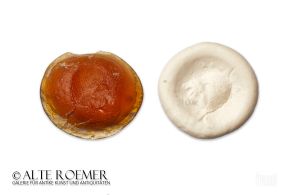 Roman glass paste
Roman glass pasteRing stone made of beautiful orange glass. From the Professor Brosch collection of ancient gems.
Price: on request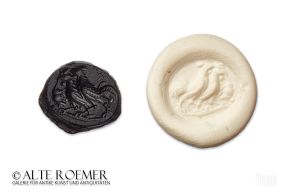 Roman intaglio with cocks
Roman intaglio with cocksThe quality work shows two standing cocks on a base line. Fantastic and crisp illustration.
Price: on request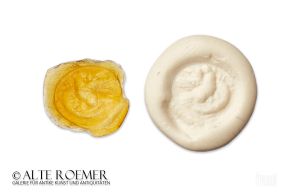 Roman intaglio with eagle
Roman intaglio with eagleThe ancient work shows an eagle in a dynamic movement spreading his wings. Beautiful orange glass paste.
Price: on request Etruscan scarab with Prometheus
Etruscan scarab with PrometheusThe highest quality work of miniature art shows how Prometheus has just formed the first human from clay. A showpiece of late Etruscan glyptics made of beautiful carnelian.
Price: on request Etruscan scarab with horses
Etruscan scarab with horsesGem stone and seal made of beautiful carnelian. It shows two horses in a frontal view in a highly stylized manner. From the famous Giorgio Sangiorgi collection.
Price: on request

